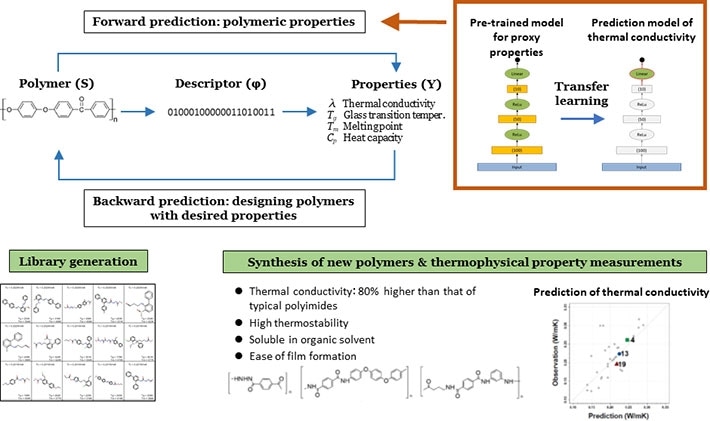Jul 22 2019
As a robust example of how artificial intelligence (AI) can speed up the discovery of new materials, researchers in Japan have engineered and verified polymers with high thermal conductivity—a property that would be instrumental in heat management, for instance, in the fifth-generation (5G) mobile communication technologies.
 The ML workflow consists of two different steps of prediction; the forward and backward predictions. The objective of the forward prediction is to create a set of prediction models that describe various polymeric properties (for example, thermal conductivity, glass transition temperature) as a function of chemical structures in the constitutional repeat units. Here, an ML framework called transfer learning was used to overcome the issue of limited data on thermal conductivity: prediction models of some proxy properties were pre-trained on given large data sets, and then the pre-trained models were fine-tuned using the limited data on the target property. Inverting the trained forward models, we derived a backward model conditioned by a desired property requirement. By solving this inverse problem, materials that exhibit the desired properties were computationally created. (Image credit: npj Computational Materials, Ryo Yoshida, Junko Morikawa)
The ML workflow consists of two different steps of prediction; the forward and backward predictions. The objective of the forward prediction is to create a set of prediction models that describe various polymeric properties (for example, thermal conductivity, glass transition temperature) as a function of chemical structures in the constitutional repeat units. Here, an ML framework called transfer learning was used to overcome the issue of limited data on thermal conductivity: prediction models of some proxy properties were pre-trained on given large data sets, and then the pre-trained models were fine-tuned using the limited data on the target property. Inverting the trained forward models, we derived a backward model conditioned by a desired property requirement. By solving this inverse problem, materials that exhibit the desired properties were computationally created. (Image credit: npj Computational Materials, Ryo Yoshida, Junko Morikawa)
The study points out the significant advantages of machine learning approaches over traditional ways of hunting for high-performance materials. A collaborative research group has shown the potential application of machine learning (ML), which is a type of AI that enables computers to “learn” from data provided to find new materials.
The research group included Ryo Yoshida (Professor and Director of the Data Science Center for Creative Design and Manufacturing at the Institute of Statistical Mathematics [ISM], Research Organization of Information and Systems), Junko Morikawa (Professor at the School of Materials and Chemical Technology, Tokyo Institute of Technology), and Yibin Xu (Group Leader of Thermal Management and Thermoelectric Materials Group, Center for Materials Research by Information Integration, Research and Services Division of Materials Data and Integrated System, NIMS).
Writing about their findings in the open-access journal npj Computational Materials, the scientists demonstrated that their ML technique, involving “transfer learning,” facilitates the discovery of materials with preferred properties even from a very small data set.
The study is based on a data set of polymeric properties from PoLyInfo, the leading database of polymers in the world located at NIMS. Regardless of its massive size, PoLyInfo has a limited quantity of data on the heat transfer properties of polymers.
To calculate the heat transfer properties from the provided limited data, ML models on proxy properties were pre-trained where adequate data was available on the associated tasks; these pre-trained models seized common features applicable to the target task.
Re-purposing such machine-obtained features on the target task produced exceptional prediction performance even with the remarkably small datasets, as if extremely skilled human experts can make rational inferences even for largely less experienced operations.
The team integrated this model with a particularly designed ML algorithm for computational molecular design, which is referred to as the iQSPR algorithm formerly developed by Yoshida and his colleagues. Applying this method allowed the identification of numerous promising “virtual” polymers.
From this large group of candidates, three polymers were chosen according to their ease of synthesis and processing.
Tests established that the new polymers possess a high thermal conductivity of up to 0.41 W/mK. This number is 80% higher than that of common polyimides, a group of frequently used polymers that have been mass-produced since the 1950s for applications spanning from cookware to fuel cells.
By checking the heat transfer properties of the computationally engineered polymers, the research signifies a crucial breakthrough for rapid, economical, ML-supported techniques for materials design. It also shows the team's collective expertise in organic synthesis, data science, and progressive measurement technologies.
According to Yoshida, many features are yet to be investigated, such as “training” computational systems to function with limited data by incorporating more appropriate descriptors. “Machine learning for polymer or soft material design is a challenging but promising field as these materials have properties that differ from metals and ceramics, and are not yet fully predicted by the existing theories,” he added.
The research is a preliminary point for the discovery of other breakthrough materials.
We would like to try to create an ML-driven high-throughput computational system to design next-generation soft materials for applications going beyond the 5G era. Through our project, we aim to pursue not only the development of materials informatics but also contribute to fundamental advancement of materials science, especially in the field of phonon engineering.
Junko Morikawa, Professor, School of Materials and Chemical Technology, Tokyo Institute of Technology
This work was carried out as part of the “Materials Research by Information Integration” Initiative (MI2I), an open innovation accelerator chosen by the Japan Science and Technology Agency (JST) as a support program for setting up an innovation hub and executed by NIMS.